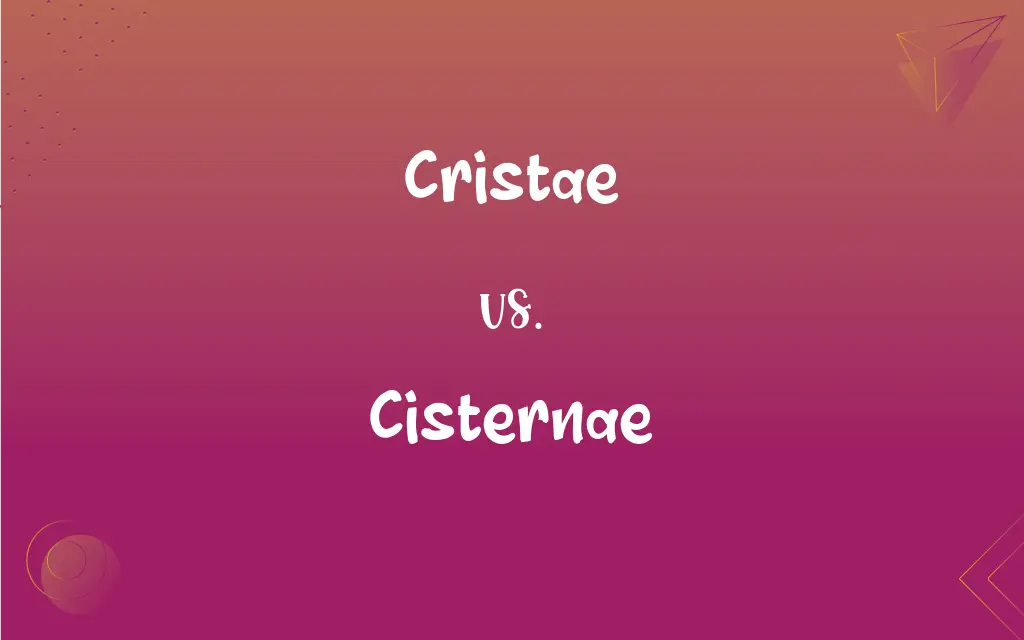Cristae vs. Cisternae: What's the Difference?
Edited by Aimie Carlson || By Janet White || Published on December 7, 2024
Cristae are infoldings of the inner mitochondrial membrane, enhancing surface area for ATP production, whereas cisternae are flattened membrane sacs within the Golgi apparatus and ER, involved in protein and lipid processing and transport.

Key Differences
Cristae, found within mitochondria, significantly increase the inner membrane's surface area, facilitating ATP synthesis by hosting enzymes and electron transport chains. Cisternae, on the other hand, are central to the Golgi apparatus and endoplasmic reticulum (ER), focusing on the modification, sorting, and packaging of proteins and lipids.
The structure of cristae allows for efficient localization of ATP synthase and other proteins crucial for cellular respiration. Cisternae are designed to optimize the processing of biomolecules, with specific enzymes and molecular markers directing the flow and modification of cargo.
Cristae contribute to the mitochondrial function of energy conversion, directly impacting cellular metabolism and energy availability. Cisternae play a pivotal role in the secretory pathway, affecting how proteins and lipids are modified, stored, and transported out of the cell.
The dynamic nature of cristae, including their shape and number, can change in response to the cell's metabolic demands, reflecting the mitochondrion's adaptability. Cisternae exhibit variability in their organization and number based on the cell type and physiological state, indicating the Golgi apparatus and ER's flexibility in handling cellular processes.
From a biogenesis perspective, cristae formation is influenced by proteins like OPA1 and MICOS complex, highlighting the regulated nature of mitochondrial architecture. The formation and maintenance of cisternae involve different sets of proteins, such as COPI and COPII vesicles, emphasizing the distinct but essential cellular mechanisms for organelle function.
ADVERTISEMENT
Comparison Chart
Location
Inner mitochondrial membrane
Golgi apparatus and endoplasmic reticulum
Function
ATP production through cellular respiration
Protein and lipid modification and transport
Structural Role
Increase membrane surface area
Flattened membrane sacs for sorting and packing
Key Processes
Hosts enzymes for the electron transport chain
Involved in the secretory pathway
Biogenesis and Regulation
Influenced by proteins like OPA1 and MICOS
Regulated by COPI and COPII vesicles
ADVERTISEMENT
Cristae and Cisternae Definitions
Cristae
Infoldings of the inner mitochondrial membrane.
Cristae increase the efficiency of ATP production.
Cisternae
Involved in lipid synthesis and processing.
The smooth ER's cisternae are sites of lipid production.
Cristae
Adapt to energy demands of the cell.
Muscle cells have mitochondria with more cristae.
Cisternae
Membrane sacs within the Golgi apparatus and ER.
Cisternae modify and package proteins for secretion.
Cristae
Regulated by mitochondrial shaping proteins.
The MICOS complex plays a key role in cristae formation.
Cisternae
Play a role in the secretory pathway.
Cisternae sort proteins based on molecular markers.
Cristae
Crucial for metabolic processes.
Alterations in cristae structure can affect cellular metabolism.
Cisternae
Number and organization vary by cell type.
Secretory cells have extensive Golgi cisternae.
Cristae
Host enzymes for cellular respiration.
Cristae are essential for the electron transport chain.
Cisternae
Regulated by vesicle transport proteins.
COPII vesicles mediate transport from the ER to the Golgi.
Cristae
(Anatomy) A crest or ridge, as on the top of a bone.
Cisternae
(Anatomy) A fluid-containing sac or cavity in the body of an organism. Also called reservoir.
Cristae
(Biology) One of the inward projections or folds of the inner membrane of a mitochondrion.
Cisternae
(Cytology) One of the saclike vesicles that comprise the endoplasmic reticulum.
Cristae
Plural of crista
Cisternae
Plural of cisterna
FAQs
What role do cisternae play in the cell?
They modify, sort, and package proteins and lipids for secretion or use within the cell.
How do cisternae differ in the Golgi apparatus and ER?
In the ER, cisternae are involved in protein folding and lipid synthesis, while in the Golgi, they further modify, sort, and package proteins.
How does the electron transport chain relate to cristae?
The electron transport chain components are located within the cristae, utilizing the increased surface area for efficient energy production.
What are cisternae?
Cisternae are flattened membrane sacs within the Golgi apparatus and endoplasmic reticulum, involved in processing and transporting proteins and lipids.
What are cristae?
Cristae are the folds of the inner mitochondrial membrane that enhance its surface area for ATP production.
How do cristae contribute to mitochondrial function?
They increase the surface area for the electron transport chain and ATP synthase, boosting ATP production.
Can the structure of cristae change?
Yes, cristae structure can adapt to the cell's metabolic needs, affecting their shape and number.
What proteins are involved in cristae formation?
Proteins like OPA1 and the MICOS complex regulate cristae morphology and function.
Why is lipid synthesis associated with the ER's cisternae?
The smooth ER cisternae contain enzymes essential for lipid and steroid hormone synthesis, playing a critical role in cell membrane composition and signaling.
Can alterations in cristae structure affect cell health?
Yes, changes in cristae morphology can impact mitochondrial efficiency and are associated with various diseases, including mitochondrial disorders.
How do cisternae contribute to the glycosylation of proteins?
Cisternae within the Golgi apparatus are sites where proteins undergo glycosylation, a critical post-translational modification for protein function and stability.
What mechanisms regulate the dynamic changes in cristae and cisternae?
Proteins such as OPA1, MICOS for cristae, and COPI, COPII vesicles for cisternae, along with cellular signaling pathways, regulate the structural adaptations of these organelles to meet cellular needs.
How are cisternae involved in protein secretion?
Proteins are modified, sorted, and packaged in the cisternae before being transported to their destination.
What is the significance of the dynamic nature of cristae and cisternae?
Their adaptability allows the cell to respond to metabolic changes and ensures efficient processing and transport of biomolecules.
How does the structure of cristae affect ATP production?
More extensive cristae provide greater space for ATP-generating machinery, directly influencing the cell's energy output.
Why do some cells have more cristae than others?
Cells with higher energy demands, like muscle cells, have more cristae to meet the increased need for ATP.
What determines the number and organization of cisternae in a cell?
The cell's function and metabolic state influence the organization and number of cisternae, with secretory cells having more extensive Golgi apparatus.
What is the role of COPI and COPII vesicles in cisternae function?
COPI and COPII vesicles regulate the transport of proteins between the ER and the Golgi apparatus, essential for the cisternae's processing activities.
What impact does physical exercise have on cristae density?
Physical exercise can increase cristae density in muscle cells, enhancing their capacity for ATP production to meet higher energy demands.
How does the structure of cisternae facilitate their function in the Golgi apparatus?
The flattened and stacked arrangement of cisternae in the Golgi apparatus allows efficient modification, sorting, and packaging of proteins and lipids.
About Author
Written by
Janet WhiteJanet White has been an esteemed writer and blogger for Difference Wiki. Holding a Master's degree in Science and Medical Journalism from the prestigious Boston University, she has consistently demonstrated her expertise and passion for her field. When she's not immersed in her work, Janet relishes her time exercising, delving into a good book, and cherishing moments with friends and family.
Edited by
Aimie CarlsonAimie Carlson, holding a master's degree in English literature, is a fervent English language enthusiast. She lends her writing talents to Difference Wiki, a prominent website that specializes in comparisons, offering readers insightful analyses that both captivate and inform.






































































